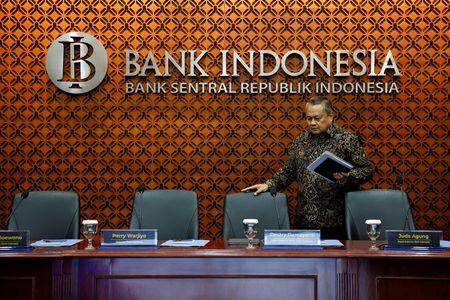By Stefanno Sulaiman and Gayatri Suroyo
JAKARTA (Reuters) -Several economists said on Thursday that they expected more aggressive easing by Indonesia’s central bank after this week’s surprise rate cut, with many noting the governor’s determination to boost growth in Southeast Asia’s biggest economy.
All 31 economists polled by Reuters had expected Bank Indonesia to stand pat, but the central bank on Wednesday cut its benchmark rate again by 25 basis points to 4.75%, against the backdrop of growing investor concerns about the country’s fiscal discipline and the bank’s independence.
The rupiah fell 0.5% against the U.S. dollar by midday break on Thursday, responding to BI’s unexpected move as well as the Federal Reserve’s rate cut. The stock index hit a fresh all-time high on positive growth prospects.
BI has now reduced its main interest rate by 150 bps in an easing cycle that started in September 2024 and has also included liquidity loosening and government bond purchases in the secondary market.
Twelve economists said they now expect more cuts in light of Wednesday’s easing, many of them adding new trims into their outlook, taking the median forecast to 4% by 2026.
Before BI’s decision, a bigger pool of 21 economists surveyed by Reuters had expected a terminal rate of 4.50% by next year.
“Governor Perry Warjiyo sounded notably more dovish than previous meetings, stating that (commercial) bank interest rates need to go down ‘immediately’, adding that BI continues looking for room to further lower interest rates,” Maybank’s Brian Lee said.
Maybank now expects BI to slash its benchmark rate by another 125 bps by 2026, bringing it to 3.50%, compared to its previous forecast of 4.25%.
Lee also underlined Warjiyo’s comments about BI working together with the government to support economic growth, following its agreement to help fund some government programmes.
Barclays’ economist Brian Tan predicts BI will bring down the benchmark to 4.25% this year, with even more cuts likely due to BI’s “all out pro-growth” stance. Barclays’ previous forecast was a terminal rate of 4.75%.
Part of Wednesday’s surprise was BI’s decision to cut the deposit facility rate even deeper by 50 bps to 3.75%, while also cutting the lending facility rate by 25 bps to 5.50%. Both rates serve as the floor and ceiling of overnight interbank money market rates.
This marked the first time since 2016 that BI will manage what economists called an “asymmetric corridor” for money market rates.
Citi Research’s analyst Helmi Arman said the decision is likely linked to the government’s policy to move more than $12 billion of its funds from BI to state banks, adding liquidity into the banking system.
Citi kept its outlook for BI’s terminal rate at 4.25%, but brought forward its expectations of the timing to the fourth quarter. It had previously expected BI to spread out the cuts until the first quarter of 2026.
(Reporting by Gayatri Suroyo and Stefanno Sulaiman; Additional reporting by Fransiska Nangoy; Editing by David Stanway)











